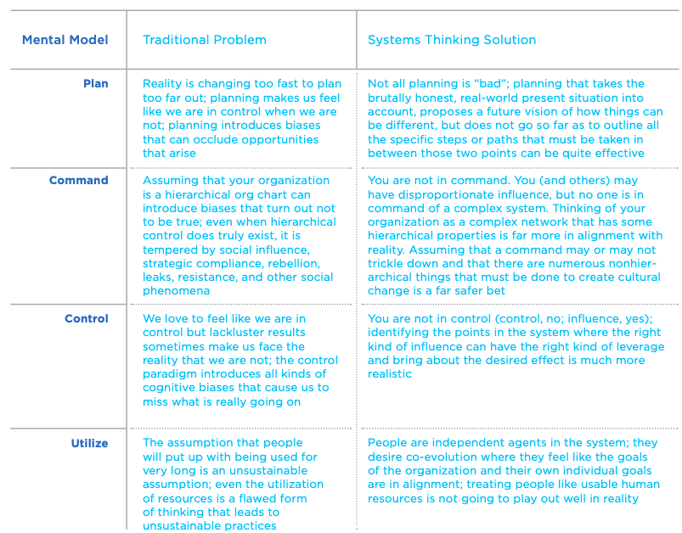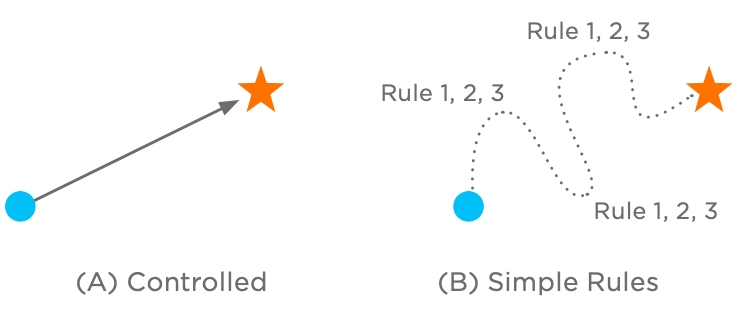The Four Flawed Mental Models Of Organizations: Mental Model #4
 Derek & Laura Cabrera
·
2 minute read
Derek & Laura Cabrera
·
2 minute read
This post is an excerpt from Flock Not Clock: Chapter 1.
Flawed Mental Model 4: Utilize
Fourth (in the traditional model), flow charts, org charts, and plans only work when we have enough human power, so we’re going to need some human resources.
Also, humans inherently like to think of themselves as resources rather than individuals with their own agency and destiny. That’s why they love to join a workforce managed by a Human Resource department. The idea here is to give the humans the plan, give them a flowchart and an org chart, tell them who they report to, and then squeeze the human juice out of them to fuel the machine. It’s all very mechanical, but it works, right? Yes. It works. This traditional model of organizations does exactly what it is supposed to do, exactly what it was designed to do: to make us feel in command and in control. It makes little difference to us whether this model of organizations is an accurate reflection of how organizations actually work.
What’s important is that it also feels like it’s working. This warm and fuzzy feeling of control is all we need, until we are faced with results we don't expect. It's these lackluster results that cause us to look for a different model. Ideally, that’s when organizations realize their need of systems thinking. Humans are quirky animals. We are independent and seek to differentiate ourselves and our identity and yet we are also extremely social animals who long to be part of a group. We have these amazing logical and analytical abilities (executive functions) and at the same time we can be petty, emotional, and retributive. We are both selfish and social. Businesses of all kinds need resources: financial, physical, and human. We don’t think of ourselves as resources. So it’s a bit of a disconnect when organizations think of us this way. We have families, loved ones, personal goals, and aspirations. When these priorities, goals, and aspirations align with those of an organization, then it’s a great fit. When they don’t, it’s a bad fit.
Yet the primary mechanism for working with humans is a department we almost always call Human Resources. That’s never a good department. We should get rid of that title in exchange for Human Engagement or Human Talent or really anything else that demonstrates an understanding of the paradox that is humanity. People want to improve. They want to be challenged to be better versions of themselves. They want to use their talents to make things better for themselves (selfish) and others (social). We humans like to be engaged in what we are doing. The best way to engage a human is to engage their thinking. Everything else is just strategic compliance. And as soon as the transactional exchange ends, the engagement ends.
But engage people’s thinking and you engage their human spirit. You won’t get 40-hours a week employees, you’ll get employees who think about things in the shower, on the way to work, and before they fall asleep. Extrinsic rewards and incentives (e.g., “carrots”) work because we are behavioral animals. We are like Pavlov’s dogs. But intrinsic motivation is rooted in engagement. Engagement is the result of three things: using your brain to solve problems, feeling like you’re part of something larger than yourself, and affecting change. The greatest threat to the traditional mental model of organizations is results. When we don’t get the results we want, we are forced to choose: Do I want to feel in control or do I want to get results? Table 1.3 summarizes the mental models that influence traditional versus systems thinking leadership of organizations.
 Table 1.3: Systems thinking provides new solutions
Table 1.3: Systems thinking provides new solutions
See the previous mental model here.
.png?width=150&height=150&name=CRL%20GOAT%20Logo%20(4).png)



